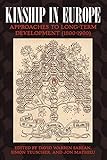Kinship in Europe : Approaches to Long-Term Development (1300-1900) / ed. by David Warren Sabean, Jon Mathieu, Simon Teuscher.
Material type: TextPublisher: New York ; Oxford : Berghahn Books, [2007]Copyright date: ©2007Description: 1 online resource (352 p.)Content type:
TextPublisher: New York ; Oxford : Berghahn Books, [2007]Copyright date: ©2007Description: 1 online resource (352 p.)Content type: - 9781845457204
- 9780857456861
- 306.83094 22
- GN575 .K56 2010eb
- online - DeGruyter
| Item type | Current library | Call number | URL | Status | Notes | Barcode | |
|---|---|---|---|---|---|---|---|
 eBook
eBook
|
Biblioteca "Angelicum" Pont. Univ. S.Tommaso d'Aquino Nuvola online | online - DeGruyter (Browse shelf(Opens below)) | Online access | Not for loan (Accesso limitato) | Accesso per gli utenti autorizzati / Access for authorized users | (dgr)9780857456861 |
Frontmatter -- Contents -- Glossary -- Preface -- Chapter 1. Kinship in Europe: A New Approach to Long-Term Development -- Chapter 2. Bringing it All Back Home: Kinship Theory in Anthropology -- Transition 1: From Medieval to Early Modern Kinship Patterns -- Outline and Summaries -- Chapter 3. Lordship, Kinship, and Inheritance among the German High Nobility in the Middle Ages and Early Modern Period -- Chapter 4. Politics of Kinship in the City of Bern at the End of the Middle Ages -- Chapter 5. Sisters,Aunts, and Cousins: Familial Architectures and the Political Field in Early Modern Europe -- Chapter 6. Political Power, Inheritance, and Kinship Relations: The Unique Features of Southern France (Sixteenth–Eighteenth Centuries) -- Chapter 7. The Making of Stability: Kinship, Church, and Power among the Rhenish Imperial Knighthood, Seventeenth and Eighteenth Centuries -- Chapter 8. Rights and Ties that Bind: Mothers, Children, and the State in Tuscany during the Early Modern Period -- Chapter 9. Kinship, Marriage, and Politics -- Transition 2: From Early Modern to Nineteenth-Century Kinship Patterns -- Outline and Summaries -- Chapter 10. Kinship and Mobility: Migrant Networks in Europe -- Chapter 11. Kin Marriages: Trends and Interpretations from the Swiss Example -- Chapter 12. Kinship and Gender: Property, Enterprise, and Politics -- Chapter 13. Kinship, Civil Society, and Power in Nineteenth-Century Vannes -- Chapter 14. Middle-Class Kinship in Nineteenth-Century Hungary -- Chapter 15. Kinship and Class Dynamics in Nineteenth-Century Europe -- Notes on Contributors -- Index
restricted access online access with authorization star
http://purl.org/coar/access_right/c_16ec
Since the publication of Philippe Ariès’s book, Centuries of Childhood, in the early 1960s, there has been great interest among historians in the history of the family and the household. A central aspect of the debate relates the story of the family to implicit notions of modernization, with the rise of the nuclear family in the West as part of its economic and political success. During the past decade, however, that synthesis has begun to break down. Historians have begun to examine kinship - the way individual families are connected to each other through marriage and descent - finding that during the most dynamic period in European industrial development, class formation, and state reorganization, Europe became a “kinship hot” society. The essays in this volume explore two major transitions in kinship patterns - at the end of the Middle Ages and at the end of the eighteenth century - in an effort to reset the agenda in family history.
Mode of access: Internet via World Wide Web.
In English.
Description based on online resource; title from PDF title page (publisher's Web site, viewed 25. Jun 2024)


